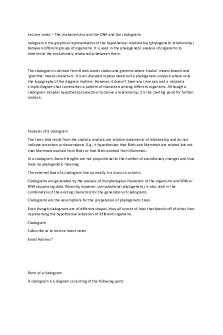Lecture notes – The characteristics and the DNA and the cladograms PDF

| Title | Lecture notes – The characteristics and the DNA and the cladograms |
|---|---|
| Course | General Biology |
| Institution | Mt. San Antonio College |
| Pages | 2 |
| File Size | 36 KB |
| File Type | |
| Total Downloads | 14 |
| Total Views | 158 |
Summary
Biology notes are useful for exams they can be used for revision, they can be used for preparing study notes!!!!...
Description
Lecture notes – The characteristics and the DNA and the cladograms ladogram is the graphical representation of the hypothetical relationship (phylogenetic relationship) between different groups of organisms. It is used in the phylogenetic analysis of organisms to determine the evolutionary relationship between them.
The cladogram is derived from Greek words clados and gramma where ‘clados’ means branch and ‘gramma’ means characters. It is an unscaled representation of a phylogenetic analysis where only the topography of the diagram matters. However, it doesn’t have any time axis and is instead a simple diagram that summarises a pattern of characters among different organisms. Although a cladogram includes hypothetical ancestors to derive a relationship, it is the starting point for further analysis.
Features of a cladogram The trees that result from the cladistic analysis are relative statements of relationship and do not indicate ancestors or descendants. E.g., it hypothesizes that Birds and Mammals are related but not that Mammals evolved from Birds or that Birds evolved from Mammals. In a cladogram, branch lengths are not proportional to the number of evolutionary changes and thus have no phylogenetic meaning. The external taxa of a cladogram line up neatly in a row or a column. Cladograms are generated by the analysis of morphological characters of the organisms and DNA or RNA sequencing data. Recently, however, computational phylogenetics is also used in the combination of the existing characters for the generation of cladograms. Cladograms are the assumptions for the preparation of phylogenetic trees. Even though cladograms are of different shapes, they all consist of lines that branch off of other lines representing the hypothetical ancestors of different organisms. Cladogram Subscribe us to receive latest notes. Email Address*
Parts of a cladogram A cladogram is a diagram consisting of the following parts:
Parts of a cladogram Image Source: BioNinja.
Root A root is the initial common ancestors of all the organisms in a cladogram. A root is the starting point for any given cladogram. However, the root might also indicate that it comes from some other larger clades. Nodes Each node is a hypothetical ancestor that gives rise to two or more daughter taxa. Nodes indicate the bifurcating branch point of divergence in all cladograms. Thus, a node exists in each point where a group of organisms divides or separate into further different groups. Clades Clades are groups of organisms or genes that include the most recent common ancestor of all of its members and all of the descendants of that most recent common ancestor. A clade is made up of an ancestor and all its descendants. It includes a particular node and all of its connected branches. Taxon / Outgroup A taxon or an outgroup is the most distantly related group of animals that isn’t necessarily a clade. This functions as a point of reference or comparison for the rest of the cladogram. Branches A branch in a cladogram is a line that connects all the other parts of the cladogram. The branch length in some cases represents the extent of divergence or the extent of the relationship among different taxa.
How to make a cladogram? (Constructing cladograms) As discussed, cladograms can be generated either based on the morphological characteristics or molecular evidence like DNA, RNA or protein sequencing. Therefore, on the basis of the characters used in the cladograms, these can be made in two different ways:...
Similar Free PDFs
Popular Institutions
- Tinajero National High School - Annex
- Politeknik Caltex Riau
- Yokohama City University
- SGT University
- University of Al-Qadisiyah
- Divine Word College of Vigan
- Techniek College Rotterdam
- Universidade de Santiago
- Universiti Teknologi MARA Cawangan Johor Kampus Pasir Gudang
- Poltekkes Kemenkes Yogyakarta
- Baguio City National High School
- Colegio san marcos
- preparatoria uno
- Centro de Bachillerato Tecnológico Industrial y de Servicios No. 107
- Dalian Maritime University
- Quang Trung Secondary School
- Colegio Tecnológico en Informática
- Corporación Regional de Educación Superior
- Grupo CEDVA
- Dar Al Uloom University
- Centro de Estudios Preuniversitarios de la Universidad Nacional de Ingeniería
- 上智大学
- Aakash International School, Nuna Majara
- San Felipe Neri Catholic School
- Kang Chiao International School - New Taipei City
- Misamis Occidental National High School
- Institución Educativa Escuela Normal Juan Ladrilleros
- Kolehiyo ng Pantukan
- Batanes State College
- Instituto Continental
- Sekolah Menengah Kejuruan Kesehatan Kaltara (Tarakan)
- Colegio de La Inmaculada Concepcion - Cebu















